If you’ve ever tried to build a website, you know the paradox: the tools keep getting easier over the years, yet the decision somehow feels harder. After all, the market is always full of builders that promise performance and sales, such as Jimdo vs Squarespace.
Between these two, which one actually holds up when you put them side by side? To answer that question, we’ll stress-test Jimdo and Squarespace across nine criteria:
- Ease of use
- AI website builder
- Design flexibility
- eCommerce features
- Blog and portfolio
- SEO & marketing
- Extensions
- Customer support
- Pricing
Keep reading!
Jimdo vs Squarespace: A Quick Overview
Jimdo pros & cons
Jimdo is a Germany-based website builder founded in 2007, which today powers over 279,000 websites worldwide. Its appeal has always been simplicity: even non-technical users can spin up a working website quickly using either pre-designed templates or Jimdo’s AI-driven builder.
Still, Jimdo’s role in the website builder market is somewhat niche. Though it provides a good starting point, the relatively small template library and limited scalability make it less appealing for businesses with ambitions to grow significantly online.
Jimdo Pros | Jimdo Cons |
Very beginner-friendly onboarding and editor | Limited design flexibility with only ~25 templates |
Affordable plans including a free tier | Weak eCommerce features that don’t scale well |
Simple AI builder that generates a draft quickly | Narrow extension and plugin ecosystem |
No transaction fees on eCommerce plans | Fewer advanced SEO and marketing tools |
Clean, straightforward dashboard | Lack of real-time support (no phone or live chat) |
Squarespace pros & cons
Squarespace was launched in 2003 and has grown into one of the largest website builders globally, with over 6.7 million users. It has built a reputation as the go-to choice for creatives, small-to-medium businesses, and professionals who care deeply about branding and presentation.
But, of course, it is not without flaws, as you can see in the table below:
Squarespace Pros | Squarespace Cons |
180+ modern templates across 14 categories | |
Fluid Engine editor allows more design freedom | No live chat or phone support |
Stronger eCommerce features with inventory & subscriptions | Smaller extension marketplace than major competitors |
Integrated SEO and email marketing tools | Learning curve can feel steeper for total beginners |
AI-driven site creation and content generation | More features locked behind higher-tier plans |
Jimdo vs Squarespace: Which Is Better?
After running both platforms through our detailed methodology, Squarespace emerges as the stronger choice overall. Compared to Jimdo, Squarespace offers more modern templates, stronger creative tools, and better integrated features for businesses looking to grow.
Nevertheless, for most users who want professional results and room for expansion, Squarespace is the safer long-term investment. You can see a quick summary of the Squarespace vs Jimdo showdown here:
Criterion | Jimdo | Squarespace | Winner |
Ease of use | Very simple setup with two clear modes | Intuitive dashboard and polished templates | Tie |
AI website builder | Fast setup with simple customization | Adds brand identity and stronger content tools | Tie |
Design flexibility | 25 templates, limited coding freedom | 180+ templates, Fluid Engine, custom code | Squarespace |
eCommerce features | Basic store tools, limited product capacity | Supports medium stores, subscriptions, inventory | Squarespace |
Blog & portfolio | Decent basics, galleries, simple blog | Full CMS blog, advanced portfolio layouts | Squarespace |
SEO & marketing | Guided SEO checklist, basic discounts | Full SEO controls, integrated email campaigns | Squarespace |
Extensions | Very limited plugins and third-party tools | 45+ apps in marketplace | Squarespace |
Customer support | Knowledge base, email/social support only | Help Center, forums, expert-matching | Squarespace |
Pricing | Cheap overall with free plan | Also quite cheap with four tiers | A tie |
Keep reading to see our detailed head-to-head comparison of each category!
Ease of Use (A tie)
The Verdict:
Both Jimdo vs Squarespace perform exceptionally well when it comes to ease of use. Each platform offers straightforward onboarding and editors that don't require a steep learning curve. Yet at the same time, they still leave room for slightly more advanced users who want to personalize their sites further.
Thanks to this balance, neither platform can truly be called the outright winner. Let's dig deeper into how they compare.
Jimdo's ease of use
We can clearly see that Jimdo makes the setup process as painless as possible. Right from the login screen, you are presented with two clear choices: “Create a beautiful website; no coding required” and “For coding experts.”
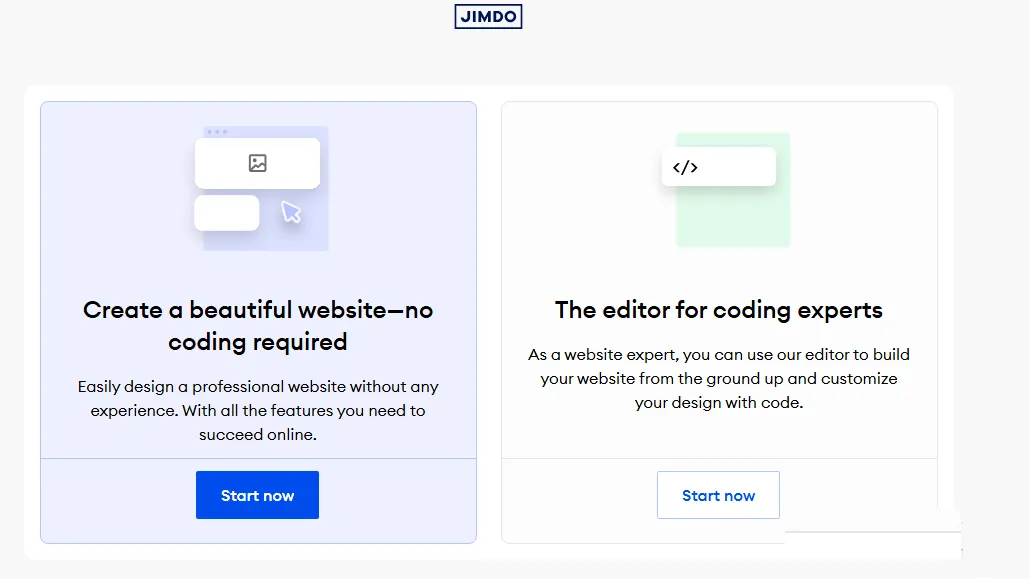
As the name suggests, beginners who don't want to touch a single line of code can head straight into the guided, no-code setup since the AI tools do much of the heavy lifting. The system will walk you through a very simple, step-by-step process to generate a personalized website in minutes.
On the other side, the “For coding experts” option gives advanced users the flexibility they need. This mode unlocks access to the site's code so developers can make extensive modifications to their sites right off the bat! We will return to this in the latter sections.
Squarespace's ease of use
Squarespace takes a slightly different path but is no less user-friendly.
Once you create an account and choose a plan, the platform immediately directs you to its curated library of templates. These templates are not only professionally designed but also tailored to different industries and use cases, so you can quickly start with a layout that already feels polished and relevant to your needs.
And when it comes to the dashboard, Squarespace keeps things just as intuitive. The main menu sits neatly on the left, with each tab leading to clearly arranged subcategories. Simply click on the area you want to work on, toggle the settings, and you're good to go; there's nothing confusing or overwhelming.
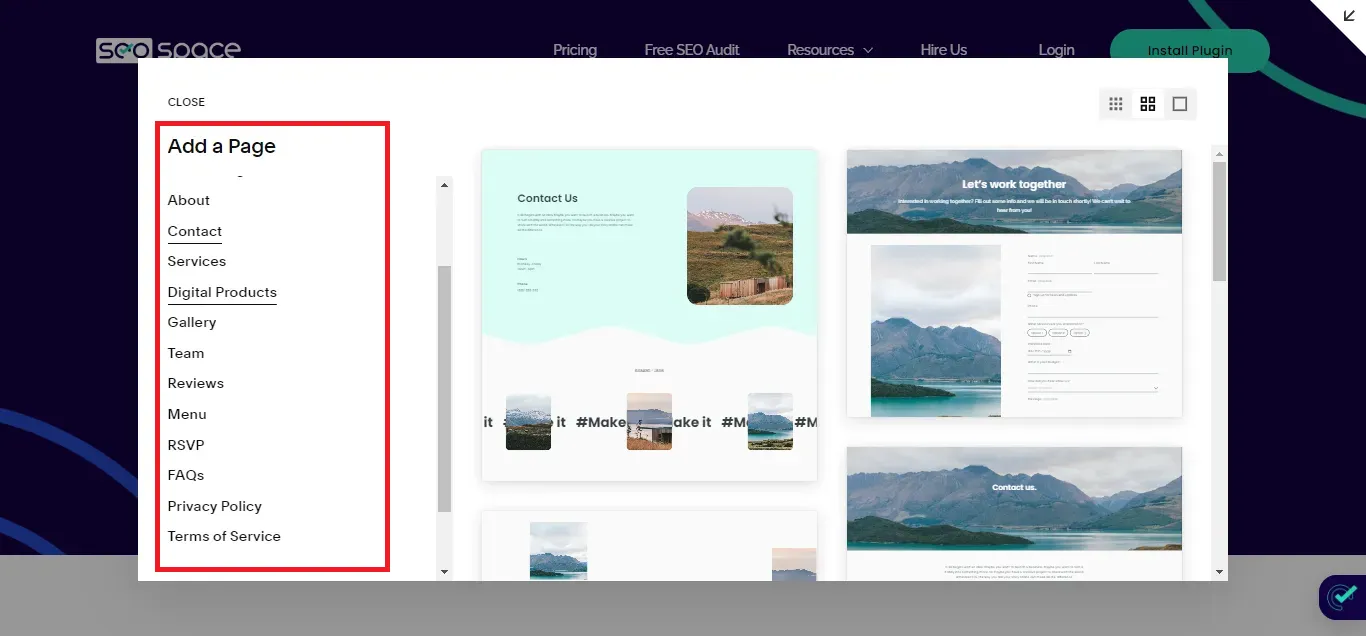
AI Website Builder (A tie)
The Verdict:
Both Jimdo vs Squarespace have taken similar approaches to AI website building. You provide some basic inputs, the AI generates a draft site, and then you step in to refine and personalize it. The experience is convenient and certainly speeds things up, but it doesn't exactly break new ground.
Where the two slightly differ is in the way they implement this process. Here's a closer look:
Jimdo's AI website builder
When it comes to Jimdo, its AI builder starts with a short questionnaire where you specify the type of site you want to create (whether it's for a business, an online store, or a personal project), along with details like your industry, brand name, and style preferences. With this information, the AI will assemble a draft site, complete with suggested layouts and sections, so you immediately have something concrete to work with.
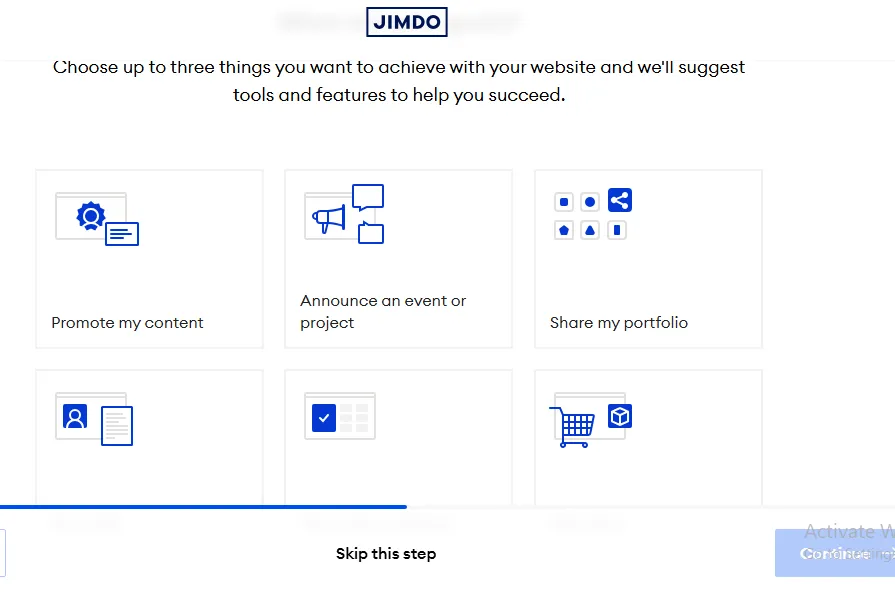
The setup becomes even faster if you already have an online presence. Jimdo can pull in information from sources like Google Business or social media, and it can also incorporate logos or images you've used elsewhere!
Once the basics are in place, Jimdo helps you refine the visual side of the site. You can upload a logo, choose a color palette, or add your own images, and the AI will adjust fonts, layouts, and styling to match. If you don't have visuals on hand, there's also a free stock library to fill the gaps. And on top of that, the builder automatically generates the key pages most sites need, like About, Contact, or Services, while giving you the flexibility to add or remove pages as you go.
However, keep in mind that Jimdo keeps customization intentionally simple, which means you won't have total creative freedom to move elements anywhere or make highly detailed adjustments. The trade-off is clear: it's quick and beginner-friendly, but not designed for pixel-perfect control.
Squarespace's AI website builder
Squarespace offers a relatively similar experience, though it takes a slightly more design-driven approach through its Design Intelligence.
Like Jimdo, the Squarespace Blueprint AI begins with a simple questionnaire that explores your business, the type of site you need, and your preferred styles. From these answers, the AI will generate a professional-looking draft site complete with layouts, imagery, and sample text.
In our opinion, what sets Squarespace apart is arguably its focus on brand identity. Early in the process, you're asked to define the tone and personality of your business (do you want to come across as approachable, sophisticated, or creative?) This input shapes not only the design but also the AI-generated content, ensuring your brand's voice is consistently carried across your site.
Squarespace also leans heavily on AI for content creation. Beyond drafting text for pages and blogs, it can write product descriptions, marketing emails, or even rework existing copy to better match your goals. And, of course, just like Jimdo, you're not 100% locked into what the AI produces: once the initial site is created, you can freely edit layouts, swap templates, adjust visuals, or refine the copy!

Design Flexibility (Squarespace wins)
The Verdict:
At first glance, both Jimdo vs Squarespace provide similar options (templates and coding). Nevertheless, Squarespace has a broader range of themes, a more modern layout system, and greater freedom for advanced customization.
Meanwhile, Jimdo's design tools still get the job done for simpler sites, but they feel far more restricted compared to the creative freedom Squarespace delivers. We will explain further in the section below:
Jimdo's design flexibility
When working with Jimdo, your design options are noticeably limited from the outset.
If you bypass the AI builder and go the manual route, you're given access to only around 25 templates! For a modern website builder, this number is underwhelming, especially when compared to competitors offering hundreds of choices. Even more concerning is that some of these themes feel outdated, both in terms of style and structure, so it's quite difficult to achieve a contemporary look without significant adjustments.

How about the second option for customization – coding? For this route, you can insert custom HTML, CSS, or JavaScript to your chosen theme (whether pre-set or AI-generated). Unfortunately, all custom code must still exist within Jimdo's existing containers, and you can't break free from the template's structural grid. Simply put, you cannot overhaul the entire page layout or build a completely custom design, and your edits remain constrained by the underlying framework.
Squarespace's design flexibility
By contrast, Squarespace offers over 180 professionally designed templates, organized into 14 categories. So whether you need a minimalistic portfolio, a bold online store, or an event page, there's always a starting point that feels modern and visually refined!

Aside from basic editing options for templates and themes (quite similar to Jimdo), what we are far more impressed with is the Fluid Engine editor, introduced in version 7.1. You can build on a flexible grid system, move blocks freely around the page, resize elements by dragging their corners, and even layer content for more dynamic layouts. This freedom allows you to break out of rigid template structures and experiment with designs that truly reflect your brand.
And that's not all; Squarespace also goes further with coding capabilities. You're able to inject custom code at both a global and page-specific level, be it HTML, CSS, or JavaScript. The platform supports code blocks and script embedding, and in some cases, you can even enable developer mode to go beyond standard design overrides. As a result, your development team not only can adjust styling but also extend functionality or completely transform how elements behave.
eCommerce Features (Squarespace wins)
The Verdict:
Though Squarespace doesn’t match the depth of platforms dedicated solely to online retail, such as Shopify or WooCommerce, its built-in features are still more robust than what Jimdo provides.
After all, the key difference between Jimdo vs Squarespace is that Squarespace has actually considered eCommerce one of its core functions, while Jimdo treats it more as an add-on within its general website-building system! Let's look closer at each platform:
Jimdo’s eCommerce features
Regarding the positives, we must say that we are pretty impressed that you can get a store online very quickly on Jimdo, which is something most small sellers or businesses testing the waters will appreciate. Plus, Jimdo doesn’t charge transaction fees on sales at all, so you only pay for your plan. Payment integration is straightforward as well, as it covers PayPal, Stripe, credit cards, and even local payment options in some regions.
Nevertheless, you should keep in mind that Jimdo is still a website builder and not an exclusively eCommerce solution.
That's why the trade-offs become clear when you look beyond the basics: if your store carries more than around 100+ products or a large number of variants, the platform begins to feel restrictive and very difficult to scale! Jimdo also doesn’t provide many advanced shipping capabilities, such as automated rules, real-time carrier calculations, or detailed customization of the checkout flow.
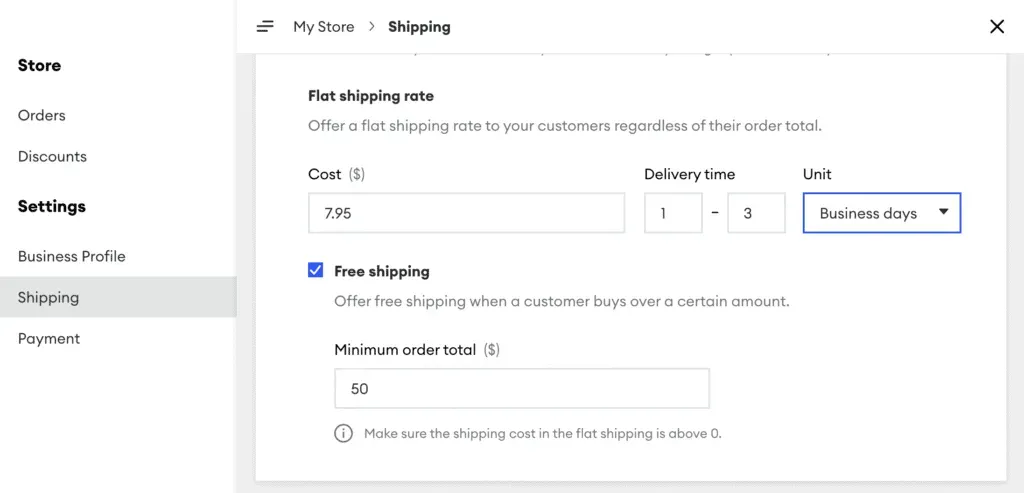
Squarespace’s eCommerce features
On the other hand, Squarespace approaches eCommerce much more seriously.
Sure, it can’t compete head-to-head with Shopify or WooCommerce, but Squarespace still provides a far more complete experience than Jimdo. The platform includes basic product and catalog management, plus decent support for multiple types of products (physical goods, digital products, and even subscription-based offerings) to open the door to more varied business models. Squarespace also comes with built-in inventory tracking, so you can monitor stock levels directly from the dashboard without relying on third-party tools.
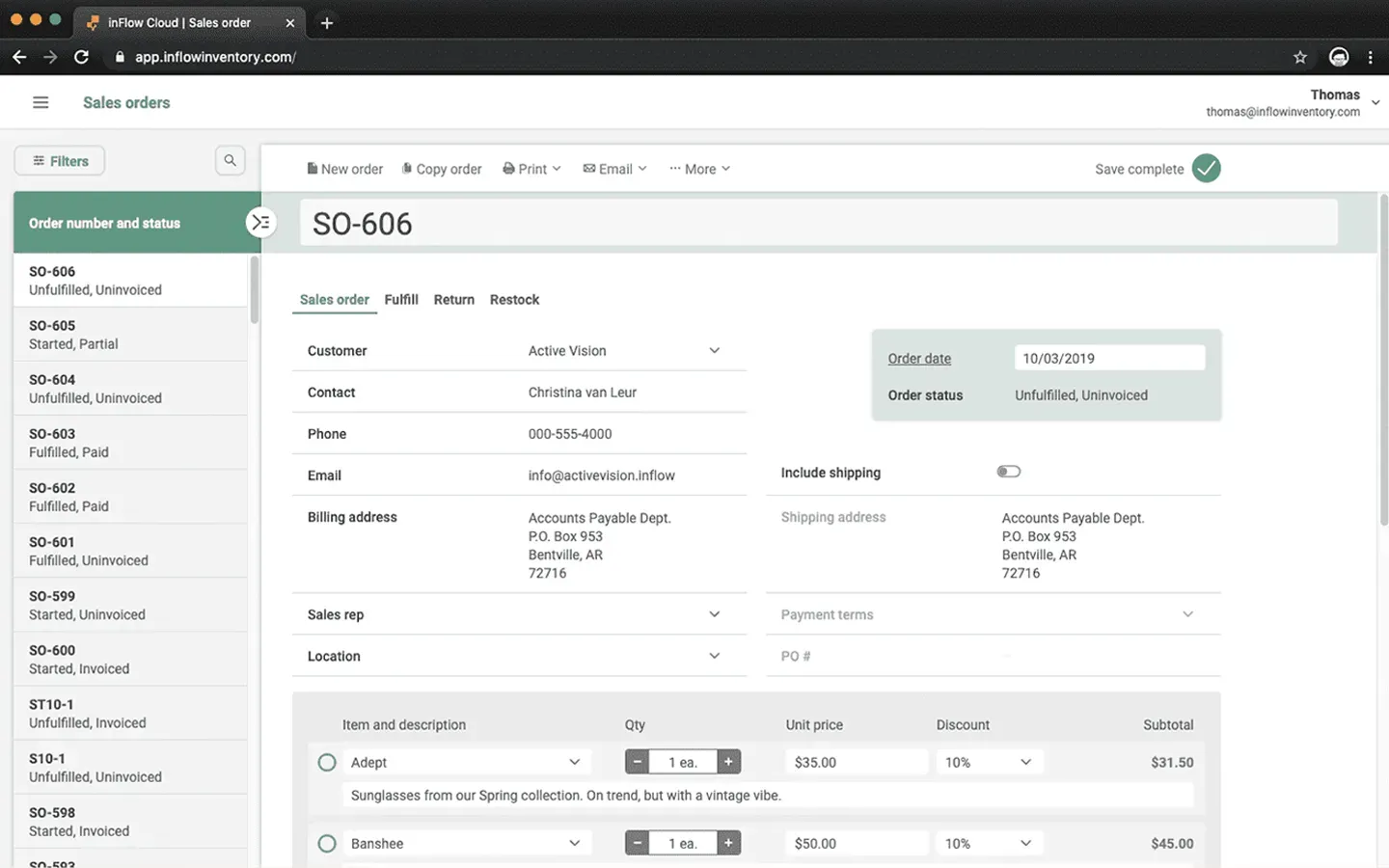
Likewise, shipping options are far more capable than Jimdo’s (though still not as sophisticated as reputed eCommerce platforms). You can configure basic shipping zones and rates that work for most small and medium businesses, and the checkout process offers a cleaner and more professional experience for customers compared to Jimdo.
Add to this the polished product page designs, and you can clearly see that Squarespace delivers a more rounded eCommerce solution than its competitor at the end of the day.
Blog and Portfolio Features
The Verdict:
Squarespace is the stronger platform for anyone serious about blogging or showcasing a professional portfolio. It combines powerful tools with flexible design options, providing the scalability needed as your content grows.
Jimdo, by comparison, mostly does a fine job for simple use cases and quick setups. Let's discuss the difference between Jimdo vs Squarespace in more detail:
Jimdo's blogging and portfolio features
For portfolios, Jimdo has built-in support for image galleries and slideshows. You can customize colors, choose fonts, or even design a basic logo directly within the platform. There are also artist and photography templates available to guide creative professionals toward building a site without much technical effort. In short, for someone looking to get a portfolio online quickly, Jimdo does the job well enough!

How about the blogging side? Jimdo also provides all the essentials: you can write posts, add categories and tags, set featured images, and insert multimedia like photos, videos, or widgets. It's also quite a breeze to enable or disable comments and share posts across social networks. The fact that blogging is supported even on free plans makes it accessible to even hobbyists or beginners who want to test the waters before investing in a paid option.
Nevertheless, the platform starts to feel restrictive once you need more advanced functionality. Portfolio layouts are limited by Jimdo's block-and-container structure, meaning you can't fully customize project pages beyond what the template allows. Blogs face a similar issue: sure, the basics are there, but you won't find advanced options like varied post layouts or customizable landing pages.
Squarespace's blog and portfolio features
Regarding portfolios, Squarespace includes dedicated Portfolio Pages and Portfolio Collections, which let you build not just galleries but full project pages with strong visual impact.
You can choose from layouts like grid, masonry, or slideshow, and then style them further with high-quality image handling, hover effects, background sections, and other design enhancements. Better yet, these pages integrate seamlessly with Squarespace's broader branding tools, image optimization features, and SEO capabilities, so your work will look polished and be easier to find online!
And when it comes to blogging, we are quite impressed that Squarespace offers a true content management system. You can create posts with categories and tags, schedule them for future publication, add featured images or excerpts, and enable comments. Social sharing is also built in, and for those looking to monetize their writing, the Business and Commerce plans even allow you to add paywalls.
Likewise, blog landing pages themselves can be customized in different layouts (e.g., list and grid) to give you control over how your content is presented. Within posts, the editor allows you to mix blocks of text, images, videos, and embeds for richer, more engaging content.
Note: On the other hand, our team has noted the way Squarespace distinguishes between blogs and portfolios in terms of design flexibility. Blog posts are still built on a somewhat simpler “classic” editor; meanwhile, portfolio pages benefit from the more advanced Fluid Engine, which lets you experiment with different layouts, backgrounds, and design elements beyond Jimdo's offerings.
SEO & Marketing (Squarespace wins)
The Verdict:
Squarespace offers dedicated email marketing plans, advanced campaign features, and automated tools such as abandoned cart reminders to provide businesses with the resources to grow and engage their audiences effectively.
Jimdo, meanwhile, does offer some helpful basics, but its scope is narrow and quickly shows its limits once you try to go beyond the essentials. This Jimdo vs Squarespace difference becomes especially apparent when you look more closely at how each platform supports visibility:
Jimdo's SEO & marketing
Jimdo tries to make SEO as simple as possible, and in many ways, it succeeds!
Its built-in tool feels more like a guided tutorial than a technical panel. It walks you through a checklist of best practices (such as adding keywords, setting meta descriptions, or making sure each page has the right headings) and marks tasks complete as you follow along. For someone with no SEO background, this system is reassuring because it guarantees you won't overlook the basics.
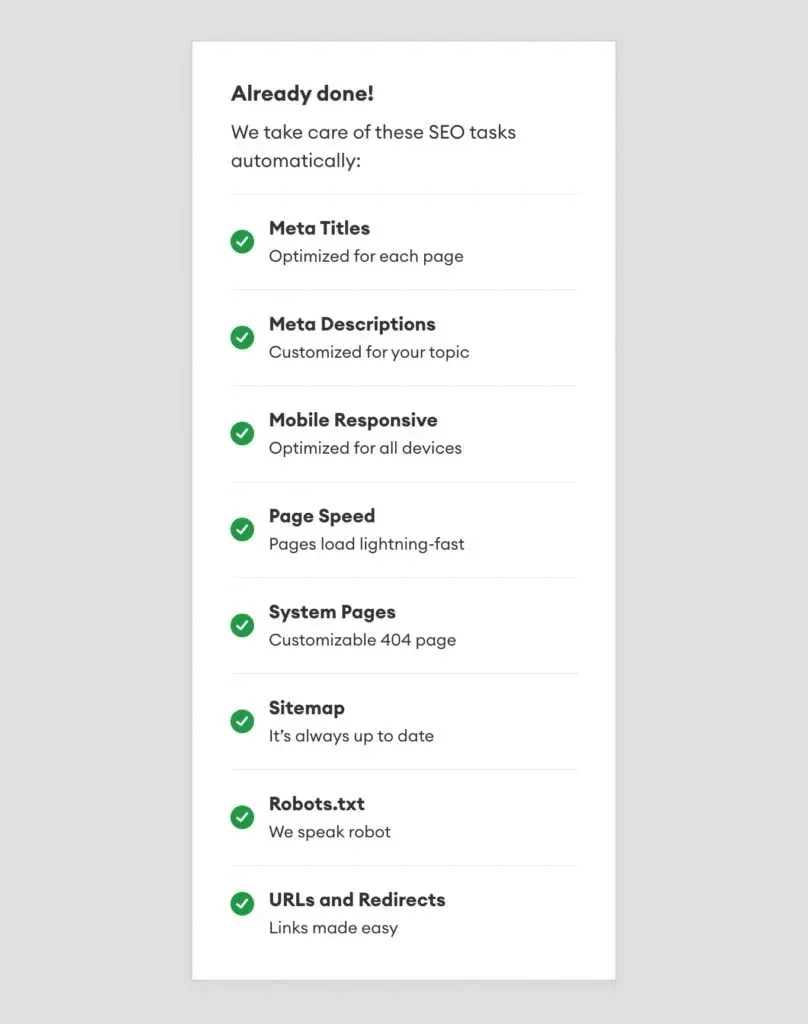
The trade-off, however, is that once the checklist is complete, you hit a ceiling. More advanced options like schema markup, detailed canonical controls, or deeper analytics are missing, so the tool is better suited for casual users than for anyone with ambitious SEO goals.
On the marketing side, Jimdo provides a straightforward discount code feature. It's easy to set up promotions: you enter the code name, choose the discount amount, set conditions such as a minimum order value, and decide when it should expire.
Needless to say, this is a convenient feature for small shops that occasionally want to run seasonal sales or reward loyal customers. But beyond that, Jimdo doesn't offer much. There's no built-in system for creating newsletters, no tools for managing subscriber lists, and no automation to help with customer engagement. As a result, businesses that want to expand their marketing efforts are forced to look outside the platform for third-party solutions.
Squarespace's SEO & marketing
Starting with SEO, Squarespace gives you direct access to all the important fields: you can set titles and meta descriptions for each page, add alt text for images, and adjust URLs so they remain clean and search-friendly.
The platform also generates an XML sitemap automatically, ensuring that all of your content is discoverable by search engines. Combined with mobile-responsive templates, which Google favors in its rankings, Squarespace builds a solid foundation for visibility without requiring external plugins or complicated configurations.
But it's in marketing where Squarespace truly sets itself apart. The platform comes with its own marketing suite, which allows you to design and send campaigns without leaving the Squarespace dashboard. You can start with elegant templates, customize them with your own images and product links, and incorporate promotional codes to drive sales. Better yet, since subscriber lists, customer profiles, and audience segmentation are all built into the platform, you can target specific groups of customers with content that actually matches their interests.

And that's not all; Squarespace also scales its email marketing through transparent pricing:
Number of emails per month | Price (billed monthly) |
500 emails | $10 / month |
5,000 emails | $20 / month |
10,000 emails | $28 / month |
25,000 emails | $40 / month |
50,000 emails | $48 / month |
100,000 emails | $60 / month |
150,000 emails | $73 / month |
250,000 emails | $96 / month |
Adding to this, Squarespace includes smart automation such as abandoned cart recovery: if a shopper leaves items in their cart, the system automatically sends them a reminder after 24 hours. Most importantly, all these reminders are fully customizable, so you can adjust the subject line, message content, and even the design to reflect your brand's voice!
Extensions (Squarespace wins)
The Verdict:
Squarespace wins this round thanks to its much wider range of extensions. That said, even Squarespace’s marketplace is still fairly limited compared to the massive ecosystems of platforms like Shopify or WordPress. So, in truth, both Jimdo vs Squarespace have room to grow when it comes to third-party integrations.
With that context in mind, let’s have a quick walk through their extension library:
Jimdo’s extensions
We must say that Jimdo keeps things quite modest in this department. At the moment, it mainly integrates with just four POWr plugins:
- The Contact Form Builder for creating custom forms
- The Hit Counter for tracking visits
- The Popups and Email Pop plugin for generating promotional pop-ups
- The Social Feed plugin that allows you to display live content from your social channels.
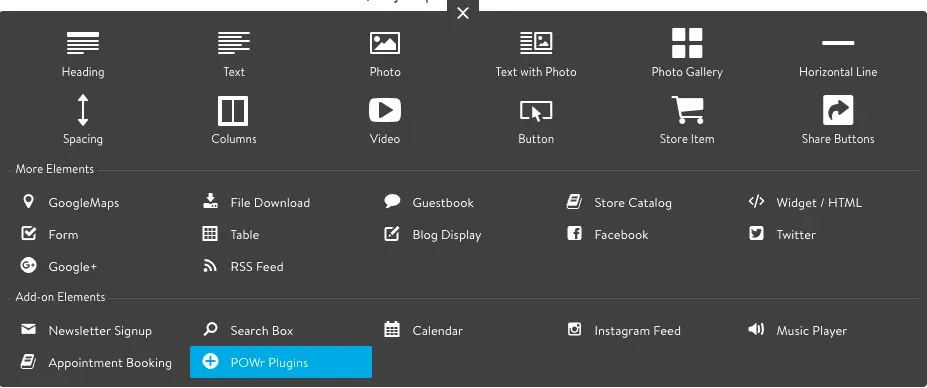
Aside from these four integrations, Jimdo also points users towards five services for adding calendar or booking buttons and three text design tools. As you can see, they make for a very slim lineup of extensions, leaving users with extremely limited options to customize or expand their sites!
Squarespace’s extensions
On the other hand, Squarespace does a better job by offering its own extensions marketplace with over 45 apps to choose from. Each app includes a “Connect to Site” button, so installation should be straightforward and quick.

Still, one common frustration is that pricing information isn’t always displayed upfront. In many cases, you have to start the installation process or create an account with the extension provider before you can see the actual costs involved. Such a lack of transparency usually makes it much harder to compare options or plan your budget at the early stages.
Customer Support (Squarespace wins)
The Verdict:
Both Jimdo and Squarespace offer self-help resources and direct support to their users. Still, Squarespace edges slightly ahead thanks to its option of connecting customers with certified experts for more intensive, personalized assistance.
In short, though neither platform is perfect, Squarespace offers just a little more in terms of going beyond basic troubleshooting. Let’s break it down further:
Jimdo’s customer support
Jimdo relies heavily on its knowledge base, which is pretty well-structured and covers most common setup and configuration issues you’ll run into. For straightforward tasks (like adjusting templates, adding content, or configuring basic features), the guides are clear enough to walk you through the process without needing to reach out for help.
And when the problem goes beyond what the knowledge base can solve, Jimdo does offer direct support, though in a more limited form. You can contact their team by submitting a request through the Help Support form, and they also maintain a presence across social media platforms like Facebook, YouTube, Instagram, X (formerly Twitter), and even Pinterest.

One major drawback we must mention, though, is the absence of real-time communication options. Jimdo does not provide phone support or live chat, which means you’ll need to wait for email responses or hope that social media outreach gets attention. Such a lack of immediacy can be frustrating if you’re facing a time-sensitive issue that needs quick intervention.
Squarespace’s customer support
Like Jimdo, Squarespace also puts strong emphasis on self-service. Its Help Center is neatly organized and packed with tutorials; at the same time, the Community Forum gives users the chance to discuss solutions and share tips. Together, these resources cover a wide range of issues and are often enough to solve everyday questions without contacting support directly.
Where Squarespace goes a step further is in its option to connect users with Squarespace Experts. If your problem requires more specialized assistance – or you want custom work done on your site – you can get matched with an expert who can provide tailored solutions. This approach can give users a more reliable way to resolve complex issues that standard guides or general support might not cover.

That being said, Squarespace suffers from the same core limitation as Jimdo: there’s no direct phone line or live chat for instant help. The only “real-time” option is a chatbot, which is primarily limited to answering common questions or pointing you to existing articles.
Pricing (A tie)
The Verdict:
Though Jimdo separates its plans more distinctly between standard websites and online stores, the overall cost of Jimdo vs Squarespace ends up being remarkably similar. For instance, Squarespace’s Commerce Advanced plan at $44/month is almost identical to Jimdo’s VIP plan for online stores at $45/month.
In other words, both Jimdo vs Squarespace require roughly the same payment for premium access. To see how they line up, let’s take a closer look at what each offers.
Jimdo’s pricing
Jimdo was one of the earlier builders to distinguish between personal website plans and eCommerce store plans.
On the website side, Jimdo provides four different tiers:
- Free: $0/month
- Start: $11/month (for personal website)
- Grow: $18/month (for business website)
- Unlimited: $45/month (for professional designs)
Meanwhile, for online stores, Jimdo offers three eCommerce-focused plans:
- Basic: $18/month (small stores)
- Business: $22/month (professional stores)
- VIP: $45/month (more advanced toolboxes)
The separation between website plans and store plans can be helpful for users who only want a simple site and don’t need shop features. However, it does mean you’ll have to move into higher-priced tiers if you want to scale your business online.
Squarespace’s pricing
Meanwhile, Squarespace takes a more all-in-one approach as it rolls hosting, security, and customer support into a single fixed price across its four tiers:
- Personal: $14/month (for personal sites)
- Business: $20/month (for websites looking to attract audiences)
- Commerce Basic: $24/month (for online stores)
- Commerce Advanced: $44/month (for advanced selling tools)
Our Methodology
Step 1: Define scope & build user scenarios
The first step in our process was to establish a clear scope for the Jimdo vs Squarespace comparison. Instead of evaluating every single feature in isolation, we narrowed the focus to only nine categories that matter most.
Plus, to avoid biasing the review toward just one type of website, we created three realistic user scenarios:
- The first was a solo creative professional who needed a simple portfolio with a blog attached.
- The second was a small retailer with fewer than 200 products that wants to sell online but does not need enterprise-level functionality.
- The third was a service-based business that primarily needed lead capture, booking tools, and email marketing.
When running each platform through these scenarios, we could ensure that our Jimdo vs Squarespace comparison spoke to a broad range of potential users rather than a single niche.
Step 2: Hands-on testing from scratch
Next, we tested both Jimdo and Squarespace by creating new accounts and building live sites from zero.
Once the basic test sites were up and running, we pushed deeper into advanced functionality, such as design flexibility, eCommerce, marketing/SEO tools, etc.
Also, customer support is often the hidden factor that makes or breaks a platform, so we deliberately tested it from multiple angles. We also made sure to evaluate broader user experience across extended use (for 2 months straight, not just a few days or weeks) to confirm the platforms felt intuitive enough that we didn’t need to reference tutorials constantly.
Step 3: Weighting & scoring
Only after completing all the tests did we move on to assigning scores. Each category was weighted according to how much it matters to the average website owner:
- Ease of use (20%)
- Design flexibility (20%)
- eCommerce (15%)
- AI website builder (15%)
- Seo & marketing (10%)
- Blog & portfolio (10%)
- Extensions (5%)
- Customer support (5%)
Within these weights, we scored based on three factors: how complete the feature set was, how easy it was to achieve key tasks, and how well the outcome matched professional standards. This combination of weighted scoring and outcome-based evaluation ensured that the final verdict reflects both what the platforms can do and how well they actually deliver for real users.
Jimdo vs Squarespace: FAQs
What is the best alternative to Squarespace?
If you’re looking for a more flexible alternative, WordPress.org paired with a good host remains the most powerful choice, especially for users who want complete control. However, for those who prefer something closer to Squarespace’s drag-and-drop style, Wix or Webflow are also strong contenders.
Is Jimdo a good website builder?
Yes, Jimdo is a good builder if your needs are simple. It’s perfect for hobby sites, small service businesses, or individuals who just want to get online quickly without high costs. On the other hand, if you expect to scale into advanced eCommerce or marketing, you may quickly find Jimdo’s limitations restrictive.
Is Squarespace still good in 2025?
Absolutely. Squarespace has continued to invest in modern design tools, AI features, and eCommerce improvements. Though competitors like Wix and Webflow push boundaries, Squarespace remains one of the most user-friendly yet professional-looking options available.
What is the disadvantage of Squarespace?
The main drawbacks are its limited extension marketplace and the absence of live phone or chat support. Advanced users may also find quite a lot of customization constraints compared to open-source platforms like WordPress (and even hosted platforms like Shopify, if you want to sell online). Still, for most medium businesses, its balance of design, features, and integrated marketing makes up for those downsides.
When to Choose Jimdo vs Squarespace
At the end of the day, choosing between Jimdo vs Squarespace depends on the type of project or business you’re running.
In our opinion, Jimdo is best suited for individuals, freelancers, or small businesses that need a website quickly and cheaply. If you’re a local shop owner, a solo artist, or someone experimenting with an online presence, Jimdo’s AI builder and low-cost plans will give you exactly what you need without overwhelming you with options. It’s also the better choice for those who want to stick with a free plan while testing the waters.
Squarespace, on the other hand, is the better fit for professionals and businesses aiming to grow. If you want your site to be not just functional but visually impressive, Squarespace’s templates and Fluid Engine editor give you far more room to create something unique! We also recommend them for small-to-medium online stores, creative portfolios, and anyone who plans to invest in SEO, marketing, or integrated email campaigns.
For more tips, check out our Squarespace guide or join our Facebook Community.


